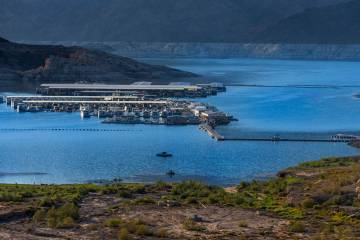Homemade plane had special OK for test flights
The homemade plane that killed three people when it crashed into a home last week was given special authorization to conduct test flights in and out of the North Las Vegas Airport, aviation officials said.
Friday's ill-fated flight was intended to test a device meant to boost the engine's power, according to what the plane's owner told an investigator with the National Transportation Safety Board.
Details of a preliminary investigation into the crash released Wednesday by the federal agency do not state the cause of the crash and leave many questions unanswered.
But the investigation reveals that a Federal Aviation Administration official granted the experimental Velocity 173 RG special authorization to use the urban airport as a hub to complete the test flight requirements.
Under FAA rules, new experimental aircraft are prohibited from flying over urban areas during the first 25 or 40 hours of flight, depending on the plane's construction.
But FAA officials can grant certain planes, on a case-by-case basis, access in and out of urban airports before those hours are completed.
The plane that crashed Friday had to pass inspections and be flown for five hours in a rural area before using the airport, according to the report.
When it left the airport last week, it had been flown 5.1 hours.
The owner had been given two options to complete the additional 20 hours: fly out of North Las Vegas and complete its remaining 20 hours while flying near Boulder City, or take a one-way flight to Show Low, Ariz., where the owner lives, and complete the hours there, according to the report.
It could not fly over densely populated areas except for takeoffs and landings.
FAA spokesman Ian Gregor said an FAA inspector, or somebody the FAA designates as an inspector, has the ability to change flight limitations.
But Gregor said he could not comment on who authorized the change, citing an agency rule not to comment on crashes under investigation.
Such arrangements are not unusual, particularly at airports that were once rural but have become surrounded by housing and other development, such as the North Las Vegas Airport, said Experimental Aircraft Association spokesman Dick Knapinski.
"A lot of it depends on type of airplane and the site of airport," he said. "There may be some situations where that might be the best circumstance possible," such as if the nearest rural airport is too far away.
Shortly after the plane's 6:27 a.m. takeoff, an air traffic controller at the North Las Vegas Airport noticed the plane was not gaining altitude, according to the report.
The controller asked the pilot, 76-year-old Mack Creekmore Murphree Jr., whether he needed help.
Murphree, an experienced pilot with thousands of hours of flight time, replied: "I'm going down, I'm going down," the NTSB report said.
The Dayton man then crashed about a mile southeast of the airport into the single-story home of Jack and Lucy Costa, an elderly couple killed in the ensuing blaze.
Murphree was also killed.
The report does not state the relationship between Murphree and the plane's owner, former Las Vegan Mike Killgore, but Knapinski said it is not unusual for owners to have other pilots fly their aircraft during initial flights.
"There are people who have a great deal of experience flying amateur-built aircraft, and people will pay them to make the initial flights, to run checks and make sure the aircraft is running properly," Knapinski said.
In Murphree's latest FAA medical application, from September 2006, he said he had amassed 6,250 hours of total flight time, according to the NTSB report.
FAA records show he owned two planes, including a different homemade Velocity aircraft, and was a licensed flight instructor and mechanic with qualifications to fly multiple types of aircraft.
He was also a licensed power plant, or engine, inspector for the FAA, records show.
The week before the crash, the plane had been ground-testing a supercharger that was on the engine. A supercharger forces air into an engine to boost engine power and make the use of fuel more efficient.
A supercharger can be helpful at high altitudes, where the air is thin, said local Experimental Aircraft Association President Terry Frazier.
Killgore told NTSB investigators that the purpose of last week's flight was to test the engine with the supercharger engaged, according to the report. The flight would be the first time the device would be engaged while the plane was in flight, he said.
Five months before, the plane had been issued an airworthiness certificate, according to the report, deeming the plane fit to fly.
The FAA initially had said that the plane had been granted an airworthiness certificate in 2002, but Gregor said the agency's records were incorrect and confirmed that its first certificate was granted on March 9 this year.
NTSB investigator Eliott Simpson said Wednesday he could not elaborate on the report. A full report, which would include a cause of the accident, could take more than a year to finish.
Review-Journal writer Keith Rogers contributed to this report. Contact reporter Lawrence Mower at lmower@reviewjournal.com or 702-383-0440.


















